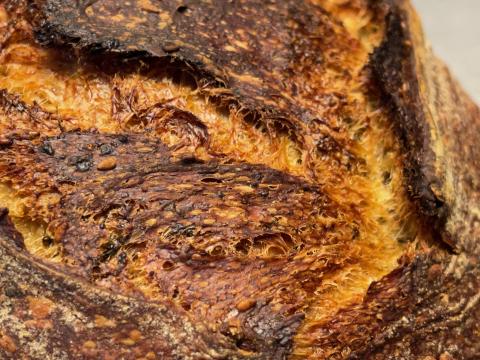
Red Miso Furikake (Sesame seeds and Nori) Sourdough

In order to bring out much more miso flavour I used my red miso and increased it to 10%.
Total Flour 494 g
Bread Flour 88.5% 437 g
Whole Wheat 11.5% 57 g all in levain
Total Water 387.5 g 78.5% hydration
Levain 115 g
Miso 49 g 10%
Salt 7.5 g
Overnight Levain build 1:6:6
In the morning dissolve ripe levain and miso in the water holding back 10 g of water. Add flour and mix until no dry flour visible. Rest for 20 mins.
Add salt and gradually add the hold back water 10 g.
Rubaud kneading x 5 mins. Rest 30 mins.
Strong bench letter fold. Set up aliquot jar. Rest 30 mins.
Lamination sprinkling on furikake (I do not measure how much is added but I like to sprinkle on quite a bit)
Do coil folds at 30 mins intervals until good window pane achieved.
Bulk ends when aliquot jar shows 60% rise. Bulk was done at 80ºF and was completed in 4.25 hours.
Shape into batard.
Left on bench until aliquot jar shows 70% rise then place in 3ºC fridge for cold retard overnight.
Next morning
Preheated oven at 500ºF
Bake 450ºF lid on for 30 mins
Dropped to 420ºF lid off 20 mins








Comments
I’ve used miso in cookies but not bread. It looks fricking delicious. And what beautiful pictures. The cutting board is incredible. Where did you get that cutting board.
Thank you Paul, if you’ve used miso in cookies, I’ve also used it in cake, then you must try it in bread. The umami is something else!
The cutting board is from a kitchen store in St. Lawrence Market here in Toronto. It has rubber feet on the bottom to keep it from moving around while cutting on it. The rubber feet are labeled Gripperwood.
Benny
Beautiful looking Loaf, Benny! I just stumbled upon your post, and it just happens (by coincidence) that earlier this month I also tried making bread with miso, in this case white miso. The result was also a dramatic looking loaf, but the miso flavor was very subdued. I should probably try red miso next time.
My loaf was all white AP flour, and like you I reduced the salt (to 1.3%). Starter inoculation was 10% of the flour weight, and bulk ferment was overnight at room temperature. Proofing time was 1 1/2 hours.
Here are a few pix of my own loaf, just for comparison - they don't quite match up to yours!
_DSC0610_lzn.jpg
_DSC0611_lzn-1.jpg
Tom your loaf looks amazing and delicious, don’t sell yourself short. Yes I think red miso will be a bit more bold than white. I only ever have red miso around, which I make myself, so that is what I always use and prefer.
Benny
Hi Benny,
Your loaf is such a rich color. The name itself and list of ingredients is unique!!
I have been wanting to try the flavors above for a long time.
This is what I put together.
500 gr total flour
-miso 5% (red)
-nori 5% (sheet form cut up in sm pieces)
-sesame seeds 2.5%
- nagaimo (Japanese gooey root vegetable) 6% (Do you remember Ben Parry's spelt comment on konjac? I believe nagaimo is related.)
-sweet brown rice (in scald) 3.5% -due to all the recent interest in it
roughly 80% hydration overall.
The dough handled beautifully and the black sesame and black nori flakes give a very nice appearance.
The most standout flavor for me was from the toasted sesame seeds. Very fragrant. Yummy.
I missed the salty umami of the miso at 5%- I will increase to 10% as you have it.
The dough is exotic and is a gift worthy.
Thanks for all the ideas!!
I love that you are into Japanese flavours and ingredients like I am Jo. Your bread sounds exotic. I haven’t had nagaimo before, I’ll have to look out for it. Black sesame is such a strong flavour, it can overpower other more subtle ones, but I love it.
I only recently realized that I didn’t calculate the salt content of my miso correctly because I didn’t account for the weight of the water that was absorbed by the dry soybeans. So based on this factor my homemade miso is about 14.3% sodium. To replace 1.8% salt in a recipe, approximately 12.6% miso will do the trick.
Benny
Pages